
Spilotes pullatus, commonly known as the chicken snake, tropical chicken snake, or yellow rat snake, is a species of large nonvenomous colubrid snake endemic to the Neotropics.

Erythrolamprus cobella, commonly known as the mangrove snake, is a species of small semi-aquatic snake, which is endemic to South America.

The brown-banded water snake is a species of aquatic snake found in tropical South America and Trinidad and Tobago. It is also known as the water mapepire.

Ahaetulla nasuta, also known as Sri Lankan green vine snake and long-nosed whip snake, is a venomous, slender green tree snake endemic to Sri Lanka.

Ahaetulla dispar, the Gunther's vine snake, is a species of tree snake endemic to the Western Ghats. It is primarily restricted to the Shola forests of the Southern Western Ghats where it is found often on high-elevation montane grasslands and the low shrub belts.
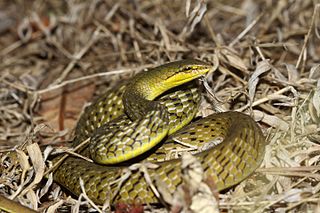
Ahaetulla perroteti, known commonly as the bronze-headed vine snake, Perrotet's vine snake, or the Western Ghats bronzeback, is a species of mildly venomous, rear-fanged snake in the family Colubridae. The species is endemic to the Western Ghats in South India.

Ahaetulla prasina is an arboreal, moderately venomous species of opisthoglyphous snake in the family Colubridae to southern and Southeast Asia. Its common names include the Asian vine snake, Boie's whip snake, Gunther's whip snake, and the Oriental whip snake.

Brown-speckled whipsnake or brown vine snake is a species of tree snake endemic to Sri Lanka. Populations in the Western Ghats of India are now considered a separate species, Ahaetulla sahyadrensis. It is known as හෙනකදයා (henakadaya) in Sinhala; this name provided the name anaconda.

Amphiesma monticola, also known as the Wynad keelback, is a harmless colubrid snake species endemic to the Western Ghats of India, where it has been recorded in the Kodagu and Wayanad regions.
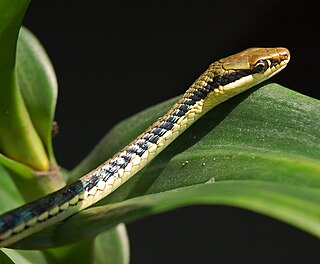
Dendrelaphis pictus, the common bronzeback, painted bronzeback, or Indonesian bronzeback, is a species of snake found in Southeast Asia and India.
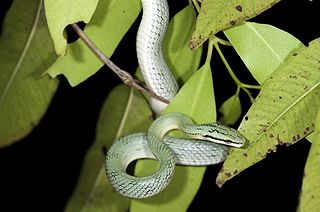
Gonyosoma frenatum, common name Khasi Hills trinket snake, is a species of colubrid snake found in Northeast India, southern China, Taiwan, and Vietnam.

Ptyas mucosa, commonly known as the Oriental rat snake, dhaman or Indian rat snake, is a common non-venomous species of colubrid snake found in parts of South and Southeast Asia. Dhamans are large snakes. Typical mature total length is around 1.5 to 1.95 m though some exceed 2 m. The record length for this species was 3.7 m, second only to their cousin Ptyas carinata among living colubrid snakes. Despite their large size, oriental ratsnakes are usually quite slender with even a specimen of 2 m commonly measuring 4 to 6 cm only around in diameter. Furthermore, the average weight of ratsnakes caught in Java was around 877 to 940 g, though larger males of over 2.3 m may easily weigh over 2.5 kg (5.5 lb). Their color varies from pale browns in dry regions to nearly black in moist forest areas. Rat snakes are diurnal, semi-arboreal, non-venomous, and fast-moving. Rat snakes eat a variety of prey and are frequently found in urban areas where rodents thrive.
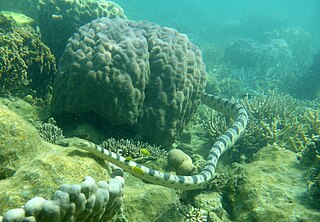
The olive-headed sea snake, also known as the greater sea snake, is a species of venomous sea snake in the family Elapidae.

Hydrophis melanocephalus, commonly known as the slender-necked sea snake, is a species of venomous sea snake in the family Elapidae.

Günther's black snake is a species of poorly known lamprophiid snake endemic to central Africa. It is the only member of the genus, Bothrolycus. This snake is notable as one of the few snakes with notable sexual dimorphism, as well as possessing a small pit anterior to the eye. While superficially similar to the thermal pits of vipers, its function remains unknown.

Oxybelis fulgidus, commonly known as the green vine snake or the flatbread snake, is a species of long, slender, arboreal colubrid snake, which is endemic to Central America and northern South America.

Snakes, like other reptiles, have skin covered in scales. Snakes are entirely covered with scales or scutes of various shapes and sizes, known as snakeskin as a whole. A scale protects the body of the snake, aids it in locomotion, allows moisture to be retained within, alters the surface characteristics such as roughness to aid in camouflage, and in some cases even aids in prey capture. The simple or complex colouration patterns are a property of the underlying skin, but the folded nature of scaled skin allows bright skin to be concealed between scales then revealed in order to startle predators.

Elapotinus is a monotypic genus created for the rear-fanged snake species, Elapotinus picteti. The species is endemic to Madagascar. It is also known commonly as Jan's snake in honor of Italian herpetologist Giorgio Jan. There are no subspecies that are recognized as being valid.
The Cameroon racer, Poecilopholis cameronensis, is a species of rear-fanged mildly venomous snake endemic to Africa. Poecilopholis is a monotypic genus created for this species.
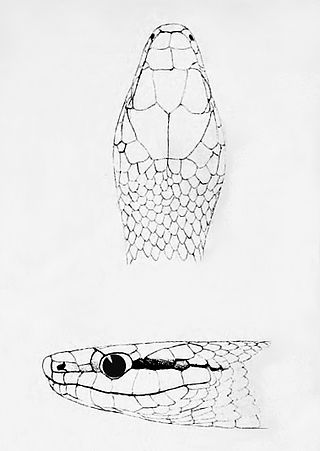
Leptophis modestus, commonly known as the cloud forest parrot snake, is a species of medium-sized slender snake of the family Colubridae. It is endemic to Mesoamerica. There are currently no recognized subspecies.





















